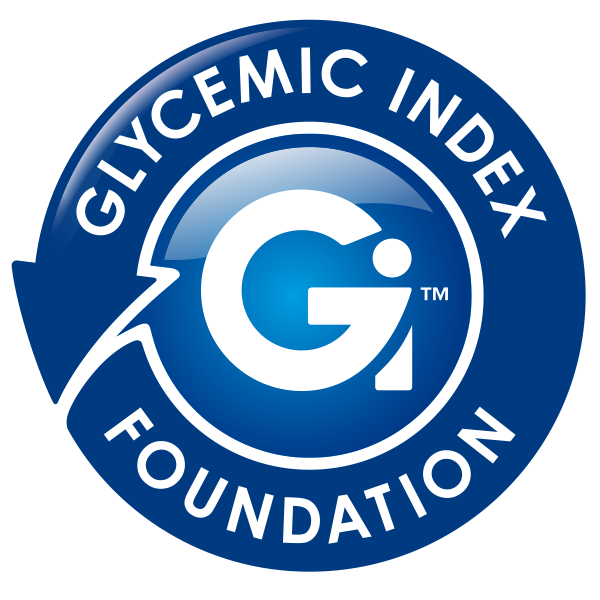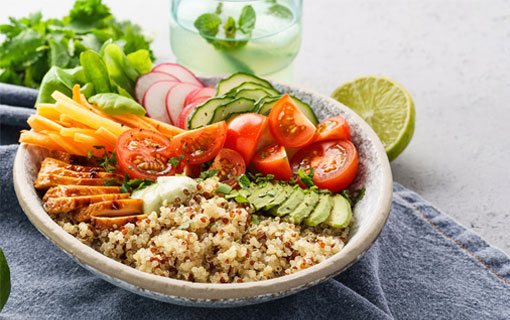GI and Weight Management
There is strong scientific evidence to prove that a diet combining both low GI and higher protein can result in effective weight loss and prevent the weight from creeping back on.
Weight management is just one of the health benefits of following a low GI diet.
This starter kit has everything you need to begin your low GI journey, while still eating all the food you love.
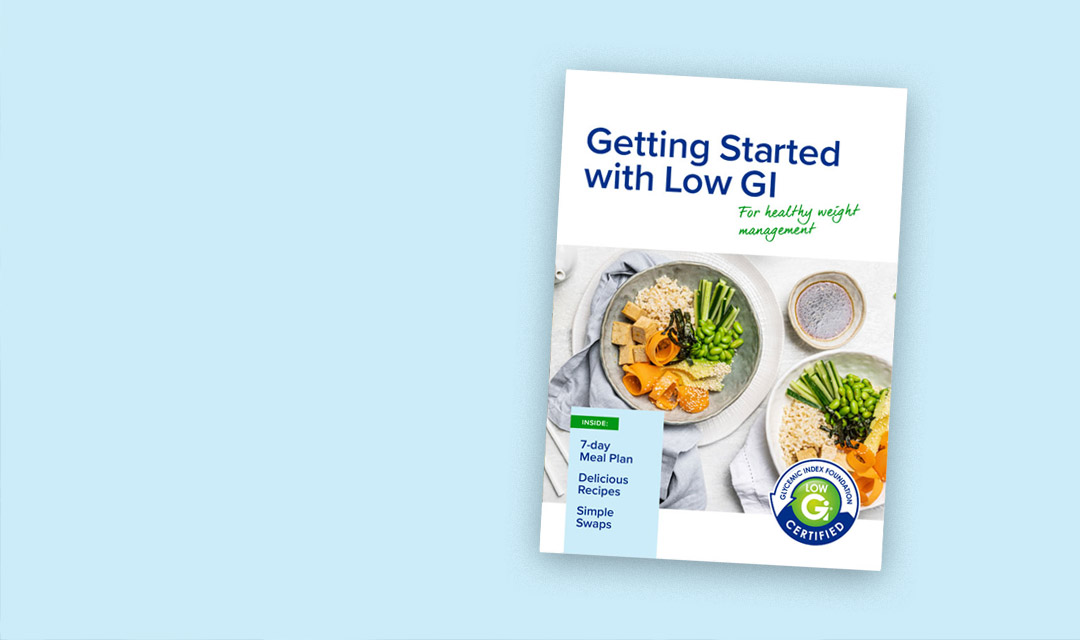
The facts at a glance
Weight loss is never easy, but it’s possible to trim down and shape up without going hungry. For long-term success, a slow and steady approach is recommended.
Increased consumption of carbohydrate foods and drinks with a high GI is widely believed to be contributing to the global obesity pandemic.
You can burn fat and shrink your waistline simply by making smart low GI carbohydrate choices. A low GI and higher protein diet can reduce insulin levels to help the body burn fat, increase feelings of fullness to delay hunger, and maintain metabolic rate.
ON THIS PAGE
PRINT, DOWNLOAD, SHARE
About healthy weight loss
The best way to achieve weight loss and maintain a healthy weight is through dietary changes and being physically active. Short-term weight loss diets generally lead to losing water and muscle tissue, not fat, so it’s best to avoid ‘crash diets’ that promise quick results. Skipping meals and cutting back drastically on food intake can also be counterproductive, causing the body to start storing up fat to help it survive.
The location where people store fat on their body is also a sign of potential health risk. The fat around your tummy – known as visceral fat – sits around the abdominal organs and poses a greater health risk. Excess body weight, particularly around the waist, contributes to insulin resistance which makes blood glucose levels difficult to control. This type of fat has been linked to a number of chronic diseases, including an increased risk of developing type 2 diabetes and heart disease.
Others store fat on the hips, thighs and buttocks. This excess fat, known as subcutaneous fat, sits just under the skin and is harder to shed.
Measure up
Standing on the scales tells you how much you weigh, but not how much of that is fat and how much is muscle. The tape measure gives a better indication of body fat:
- Stand in front of a mirror in bare feet and measure directly against your skin
- Use a flexible tape measure which is made of a material that’s not easily stretched
- Wrap the tape measure around your waist halfway between the top of your hip bone and your lowest rib. On men, this may be roughly in line with the belly button
- Stand up straight and breathe out normally as you pull the tape so that it is firm against your body, but isn’t squeezing into your skin
- You may like to measure up a couple of times to double check
Waist measurements for men:
Waist measurements for women:
*These are a guide only. Men from an Asian or South Asian background, and men and women from an Aboriginal background, may be a few centimetres lower than this. Men and women from a Pacific and Torres Strait Islander background may be a few centimetres higher than this.
Long-term waist loss goals
If you need to shrink your waist, aiming to lose around 5-10% of your initial waist measurement over three months and then keeping it off, is a healthy and achievable waist loss goal.
Realistic targets include:
- Short-term goal: Reduction in waist measurement by 1-2cm over one to two weeks
- Long-term goal: Reduction in waist measurement by 5-10cm over 12 weeks
How a low GI lifestyle can help
For those needing to lose weight and keep it off, incorporating low GI and higher protein foods into your daily diet can help achieve this. Low GI foods help facilitate weight loss in a smart and sustainable way by:
- Reducing insulin levels, which plays a role in fat metabolism
- Facilitating greater fat loss – low GI foods help burn more body fat and less muscle
- Promoting satiety and delaying hunger due to a slower rate of digestion
- Reducing food cravings
- Helping maintain long-term weight loss
Tip: Did you know that you can burn fat and shrink your waistline simply by making smart low GI carbohydrate choices.
Low GI lifestyle tips
Lifestyle changes are important when managing your diabetes. Enjoying healthy foods and being active are the best first steps to implement change, however stopping smoking, getting enough sleep and eating mindfully will also help to manage blood glucose levels and body weight.
For a person with diabetes there is no need to prepare separate meals or buy special foods. It’s about simple low GI swaps, smart lifestyle choices and self-care to help maintain a healthy weight.
- Make the switch to low GI foods and look to reduce the overall GI and GL (glycemic load) of your meal
- Keep carbohydrate portions moderate at each meal and aim for ‘the ideal plate’. Half the plate should be vegetables, a quarter should be healthy low GI carbohydrates, and the final quarter filled with lean protein
- Spread consumption of carbohydrate-rich foods evenly throughout the day
- Small regular meals can help maintain energy levels, manage appetite and keep blood glucose levels within the target range
- Exercise regularly, aiming for at least 30-60 minutes of moderate exercise every day. Weight bearing exercises such as walking will also help you build strong bones and strengthen your muscles so they burn fat more efficiently
- Losing 5-10% of your body weight has been shown to help manage blood glucose control
It is important to recognise that everyone’s needs are different. All people with diabetes should see an Accredited Practising Dietitian in conjunction with their diabetes team for individualised advice.
Studies have shown that following a low GI, high protein diet can be 50% more effective for body fat loss in obese adults, compared to a low-fat diet.
Research and further reading
- Diets with high or low protein content and glycemic index for weight-loss maintenance
- Effect of the glycemic index of the diet on weight loss, modulation of satiety, inflammation, and other metabolic risk factors: a randomized controlled trial
- Low glycaemic index or low glycaemic load diets for overweight and obesity
- Long-term effects of dietary glycemic index on adiposity, energy metabolism, and physical activity in mice
- Glycemic index and satiety: A systematic review and meta-analysis, Postelnik T., Barclay A.W., and Petocz P. June, 2015 (currently being updated)
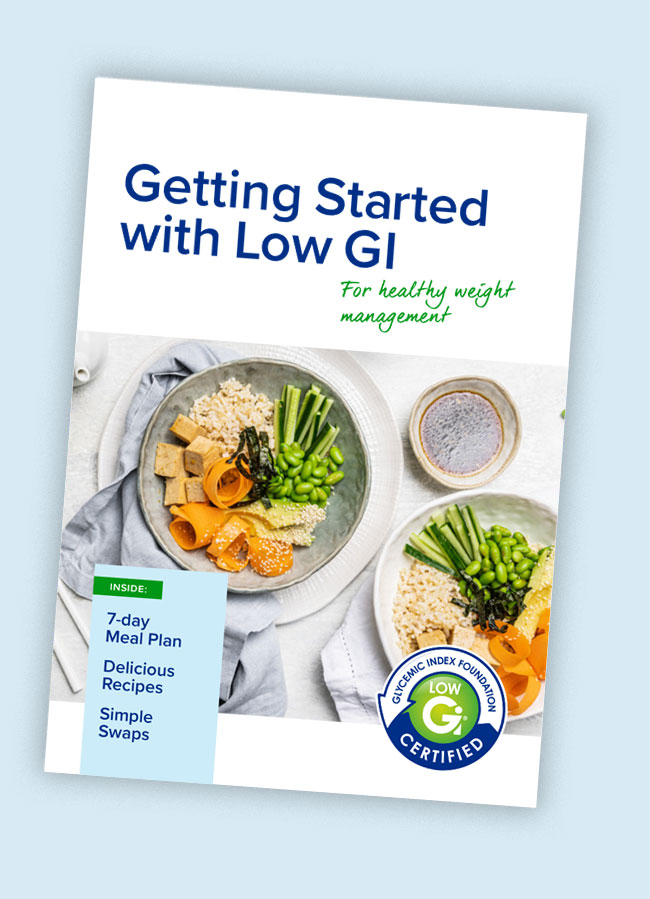
Weight management is just one of the health benefits of following a low GI diet.
This starter kit has everything you need to begin your low GI journey, while still eating all the foods you love!
Download resources
Recommended for you
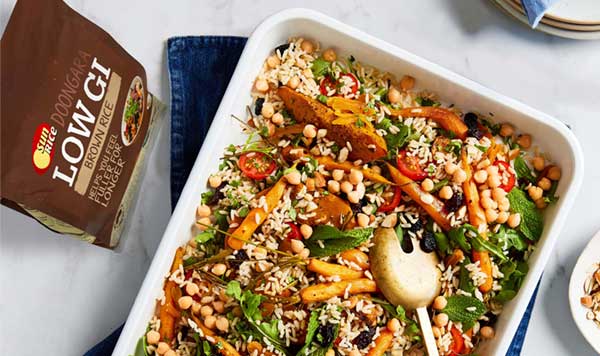
RECIPES
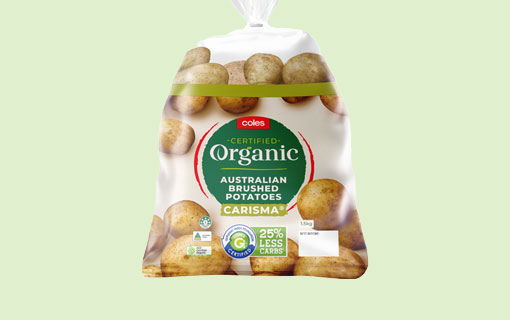
GI CERTIFIED PRODUCTS
DIABETES

LOW GI LIVING
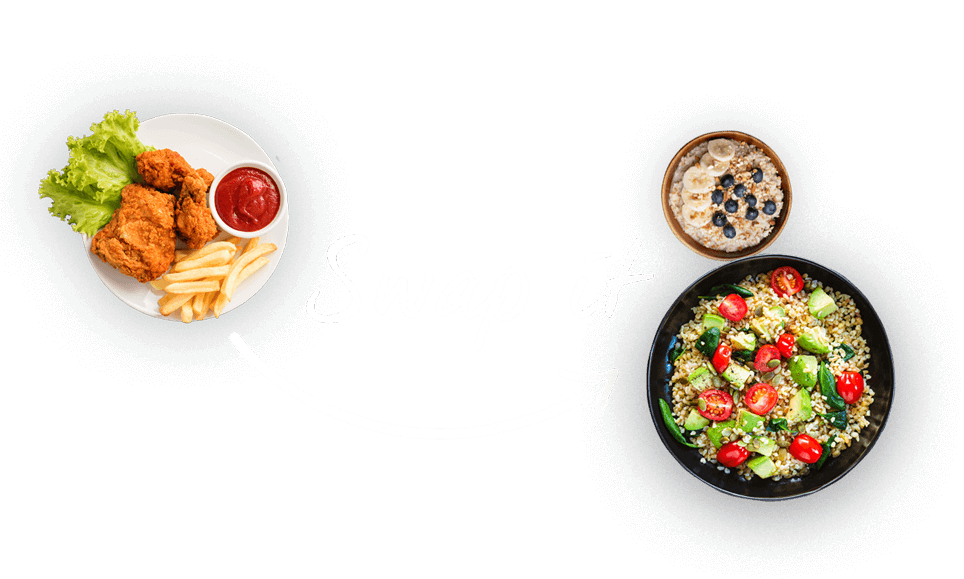

A low GI diet focuses on the quality of carbohydrates you eat. Good carbohydrates (or low GI carbohydrates) are more slowly digested helping keep your blood sugars stable, whereas bad carbohydrates cause your blood glucose levels to peak and crash. Want to know which carbohydrates are best for you? Try our swap it tool!
